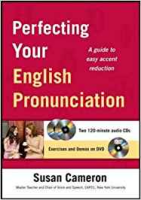

| Book of the Month | ||
 |
Perfecting Your English Pronunciation |  |
Publisher: McGraw-Hill Education
Author: Susan Cameron
$14.56 (paperback and DVD)
ISBN: 978-0071750172M
Accents are something of a hot topic in the EFL world right now. Once the aim of teachers was to produce a perfect 'BBC' accent from their students. Recently that idea has changed, and as this book explicitly says, the aim is now not to have 'everybody sounding alike' but for English learners to manage the sounds of spoken English well enough to produce clear, recognizeable speech. This is less easy than it sounds, because English has - for instance - twenty-four vowel sounds, which is more than most languages. Mastering a new part of speech later in life is very difficult - which is why, for example many Chinese people have trouble with the letter 'r' and why most westerners are hopeless at Chinese inflections.) The author is a speech consultant and accent specialist, and her book (with accompanying DVD) concentrates on getting the tongue and larynx in the right position to produce the desired sounds. Since the author is based in New York, we can assume that the final 'perfected' pronunciation offered by the title will come with an American East coast twang, but this is not necessarily a bad thing.
The book itself has 229 pages, including an index and the key to the DVD. The contents have four major parts spread over nineteen chapters. 'Getting Started' (Part One) shows which muscles are going to be used to form sounds, and presents the phonetic alphabet, which remains essential study for anyone serious about pronunciation. Part Two shows how to make the consonant and vowel sounds used in English, with the DVD showing how the tongue should be placed, and the sounds which should result from that placement. Part Three brings in syllables and word stress. This topic is large, because syllable timing is a major part of English speech, as is carrying over consonants. (For example English speakers write 'An apple' but say 'a napple'.') This part gives the essentials, but students should note that there is still more to learn on this topic.
Part Four is putting it all together, so that a student can speak entire sentences in well-pronounced English.
Because illustrations come with the DVD, there are no pictures in the book, which is well laid out. It is easy to read and understand the author's point on every page, and the book lacks the large amounts of empty white page which are a common feature in many EFL books coasting a lot more. There are many lists of words with matching sounds, and one criticism here is that the book could have done the same thing with simpler words. This would make it even more useful for students early in their language studies. Some of the explanations are also rather technical and hard for non-native speakers to understand. While this book is for elementary and upward, those at the elementary stage might do well to work with a tutor on some of the difficult exercises.
So who is this book for? Well, the author claims to have helped 'thousands' with her work, and has personally tutored executives and politicians for whom it is at times essential that they be clearly understood. While personal tutoring is valuable, it is not always possible, and this book is useful because it can be used either on its own (though the DVD is essential) or with a tutor. One problem with the book is that it is designed with a 'one size fits all' philosophy. This means that Poles and Peruvians can both get something useful from the book, though the issues in pronouncing English are very different for Spanish speakers and Slavic ones. Therefore much of the book spents time training speakers in parts of English that they have already no problem with. A book of - for example - English pronunciation for Japanese speakers would be more useful to a Japanese student, bit obviously rarer and more expensive.
Verdict: Verdict – Very competent, but occasionally too technical
Assessment 7/10